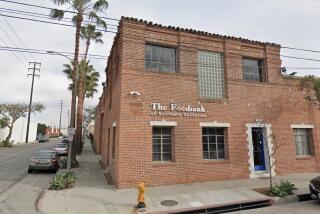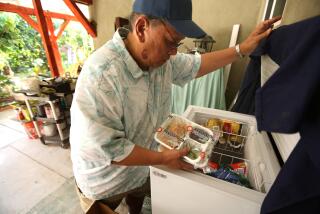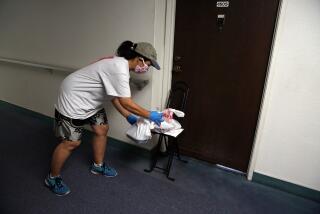Affluent San Mateo County Boosts Food Services for Needy
- Share via
SAN MATEO, Calif. — Food services for the growing ranks of the needy--in one of the nation’s richest counties--are being expanded with the merger of two food banks and the opening of a refurbished food warehouse.
While panhandlers and homeless people are still, for the most part, unheard of in San Mateo County, the people trying to feed the hungry have found it necessary to call on more experienced and organized colleagues to the south.
San Mateo County, stretching down the peninsula from San Francisco to the edge of Silicon Valley, boasts a bayside string of tidy suburbs and several pockets of extreme affluence, such as Hillsborough. Along the Pacific Coast are small beach towns, and a hilly watershed area forms the county’s scenic spine.
With the exception of depressed East Palo Alto, the county is predominantly white and prosperous. In terms of per capita income ($15,819), it ranks 22nd among more than 3,000 U.S. counties, according to 1985 Census Bureau figures.
In all of California, only Marin County has a higher per capita income.
Despite all the obvious wealth, the disparity between rich and poor has become more evident, and there exists a nutritional void that is addressed primarily by private, nonprofit charities.
“There’s sort of a de-urbanization of hunger in America today,” said Mary Heising of a newly merged food bank serving San Mateo and Santa Clara counties. “A lot of the hunger is spreading out into suburbia. It’s much more complex and it’s reaching far more people than ever before.”
New Food Bank to Open
To streamline the distribution of food to the needy, the San Mateo County Food Bank merged with the much larger and more experienced Food Bank Inc. of Santa Clara Valley, forming a new entity called Second Harvest Food Bank of Santa Clara and San Mateo Counties.
The food bank, which officially opened last month, is affiliated with Second Harvest, a national food solicitation and distribution agency founded in Phoenix in 1979.
Second Harvest received federal money until 1984 and since then has been funded solely by the food industry, foundations, corporations and private individuals.
The new food bank, according to board member Richard Brelsford, will be able to more effectively collect food from a variety of sources and deliver it to dozens of churches, halfway houses and community groups.
“The merger is an excellent move,” Brelsford said. “We can only become stronger in our county because of this merger.”
Last year, the San Mateo Food Bank distributed 2.5 million pounds of food to 50 agencies, who in turn fed thousands of people. Five hundred were members of the Brown Bag program, which puts a bag of groceries on the doorsteps of elderly residents on a weekly basis.
In Santa Clara County, which has a much larger percentage of poor and indigent people, the food bank was four times as large, handling about 10 million pounds of food for 200 agencies. Their Brown Bag program alone had 7,400 members.
The merger was the brainchild of Catholic Charities of San Mateo County, which administered the food bank after the federal money dried up in 1984.
“Our goal has always been to spin off the agency and have it operate independently,” said Mary Gonyea Lund of Catholic Charities. “It became clear that the best course of action was (the merger). We feel that the merger is the best way to serve the community.”
In addition, Heising said, cutbacks in the U.S. Department of Agriculture commodities program threatened to sink the entire food bank. The USDA had provided about 80% of the food bank’s supplies--cheese, butter, dry milk, flour, rice, honey and cornmeal.
“We were in really dire straits, Heising said.
Heising estimated at least 15,000 people in San Mateo County depend on food banks. These people, she noted, are much less visible than the homeless people one sees on every urban street corner.
“Many are suffering because it’s such an expensive place to live,” Heising said. “They’re low- to moderate-income, or they’re in between jobs. If they lived in Modesto or Kentucky, they might be OK.
“And we’ve got a lot of elderly people who just can’t afford to eat,” she continued. “Some of these people worked all their life and they just can’t get by on Social Security.”
More to Read
Sign up for Essential California
The most important California stories and recommendations in your inbox every morning.
You may occasionally receive promotional content from the Los Angeles Times.










